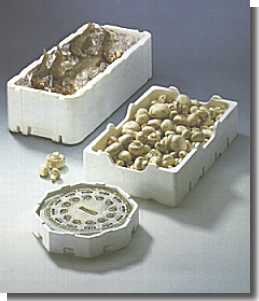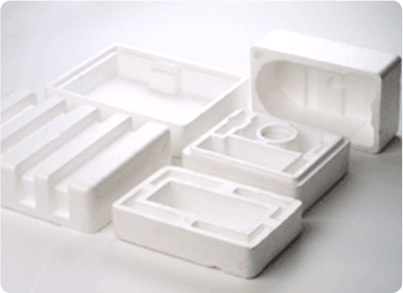EPS foam starts at very small beads - similar to sand in texture called polystyrene - The raw material is called Styrene.

Styrne can be found nearly everywhere, in your local food store and the local electronics stores. The plastic utensils are made of - Styrene, CD cases and cloth hangers - all made of Styrene.
EPS which means Expanded Polystyrene, starts as the small beads shown in the image to the left. The next step in the process is to "blow" these small beads into larger beads about 50 times its original size.
Depending on the density required, the beads are blown using steam in a machine called "expander. The expander can be a simple machine that a worker places the raw material. and then turns on the steam, or an automatic machine where the material is weighed automatically Steam, then is enables (automatically) and then stopped. At this stage, the beads are up to 50 times their original size.

Continuous pre- expanders are operated without pressure and are
equipped with an open- top agitator tank in which raw material is continuously
fed from the bottom by an adjustable screw conveyor.. Steam is "also fed continuously into the pre- expanding room through openings that are positioned shortly above the tank
bottom. An agitator and fixed breaker rods make it more difficult for bead clusters to develop; they keep the beads in motion and make sure that already pre-expanded beads
of lower density move to the top of the bead bulk and fall into a shaft through a height- adjustable discharge opening.
Pre- expanders for the so- called "second pass expansion" of already expanded materials, are equipped with an especially large feed screw in order to transport the already expanded material to be steamed again. All pre- expanders have in common that the completely expanded beads trickle into a so- called fluid bed dryer where they are dried andstabilized before they are transported into the storage silos
Here is a photo of a Pre-Expander Machine:

The two most common blowing agents used are pentane and carbon dioxide - neither contains CFCs. This process - polymerization - fills the polystyrene with millions of air pockets, which helps it to expand and also gives it a low thermal conductivity.
During expansion, the product can be molded into a variety of shapes and sizes.
The final product is 90% air, but amazingly, EPS can have a compressed strength up to 40 psi.

Bellow is a typical foam plant layout which includes the Boiler, steam tank, pre-expander, Silos and the block molds. To the left the drying area and the raw material storage.
EPS raw material should be stored in a cool place less then 70F.

The last step in the process is the mold machine. Mold machine are divided into two main categories Block molds and shape mold machines.
Block mold machines create a block of foam - from 3' x 2' x 8' up to 5' x 5' x 24'

Above image shows a manual block mold - manual means that once the molding process is done The workers need to open the doors of the mold in order to remove the block from the mold. On the machine above, this process is done manually

Picture above shows an automatic EPS block mold machine.

Shape Mold Machines create different shapes: bicycle helmets, surfboards, RC planes, packing foam, food packing and any shape imaginable that is not a block.




Comments